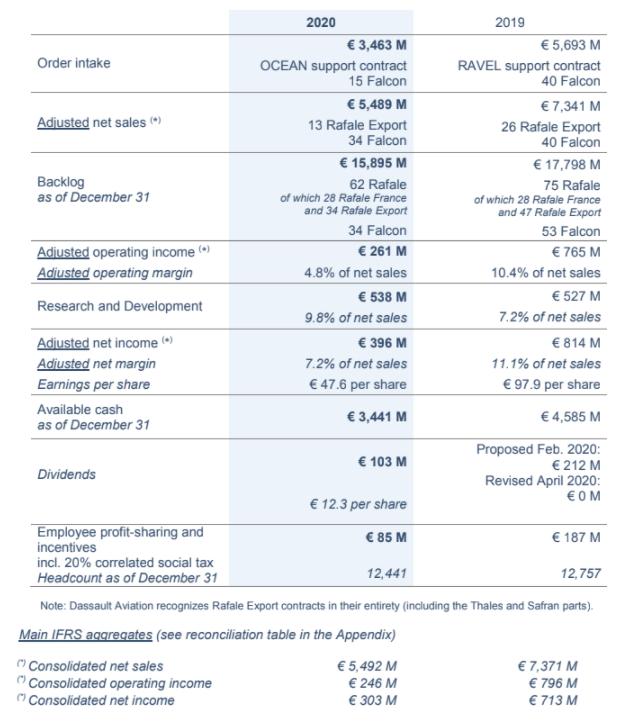
Saint-Cloud, March 5, 2021 – The Board of Directors approved the 2020 accounts at a Board meeting chaired by Mr. Éric Trappier yesterday. The audit procedures have been completed and the audit opinion is in the process of being issued.
“2020 was an extraordinary year, dominated by the Covid-19 pandemic that plunged the entire world into a health and economic crisis. This crisis allowed Dassault Aviation to demonstrate the relevance of its dual model as well as its resilience ability. Following the initial shock, our organizations have had to adapt by implementing a robust health protocol to ensure the safety of our employees, and “under crisis remote working” for most of them.
In this extraordinary context, we focused on meeting our commitments:
∙ providing support for the armed forces and Falcon customers,
∙ completing Rafale Export and Falcon deliveries,
∙ continuing to develop the Falcon 6X.
In addition, some delays were caused by the necessary changes in work organization (workplace shutdown, “under crisis remote working”, sub-contractor delays, etc.).
The aviation sector has been hit hard by the shutdown of a large part of air traffic. The French government has supported the sector through state-guaranteed loans and a furlough scheme. It has also launched a plan to support and modernize the sector in association with GIFAS.
In 2020, Dassault Aviation:
∙ received € 6 million of state temporary furlough allowance,
∙ paid € 1 million to the investment fund out of the € 13 million commitment,
∙ received € 8 million from CORAC.
In these exceptional circumstances, our shareholders have shown their support by waiving their 2020 dividends due in respect of the 2019 earnings.
As guided, we delivered 13 Rafale Export and continued to explore new Export opportunities. This led to the successful sale to Greece, in January 2021, of 18 Rafale (6 new aircraft and 12 aircraft recently put into service with the French Air and Space Force). Following the sale, France announced the order of a further 12 Rafale to replace those to be delivered to Greece.
We also successfully delivered 34 Falcon (despite the travel restrictions), continued working on the Falcon 6X which completed its virtual rollout in December 2020 and that is expected to enter into service in late 2022 and continued to develop the future Falcon to be announced in the first half of 2021.
The 2020 order intake amounted to EUR 3,463 million, versus EUR 5,693 million in 2019. This year, it included the integrated support contract for the Atlantique 2 (OCEAN) for France and 15 Falcon, including the “Albatros” maritime surveillance aircraft program for the French Navy. In 2019, it chiefly comprised the RAVEL contract and 40 Falcon.
Net sales in 2020 amounted to EUR 5,489 million, versus EUR 7,341 million in 2019. This reduction, as planned, is mainly due to a lower number of Rafale Export deliveries (13 vs. 26 in 2019) and Falcon deliveries (34 vs. 40 in 2019).
Operating margin was 4.8%, versus 10.4% in 2019. It is directly affected by:
∙ the financial impacts due to the health crisis (under-used capacity, cost of health measures, decline in activity at Falcon maintenance centers, etc.). The savings associated with the action plans implemented by the Group have cushioned these impacts,
∙ the significant level of self-financed R&D, representing 9.8% of net sales, compared with 7.2% in 2019. Despite the crisis, we aimed at keeping our current developments going, particularly the Falcon 6X and the future Falcon,
∙ less absorption of fixed costs due to the 25% drop in net sales.
2020 adjusted net income, down 51%, stood at EUR 396 million, representing a net margin of 7.2% of net sales, versus 11.1% in 2019. This decrease is mainly due to the lower operating income and the smaller contribution to net income from Thales.
This result leads to a dividend proposal of EUR 103 million (EUR 12.3 per share) for shareholders and to a payment to employees of EUR 85 million, including the correlated social tax, by way of profit-sharing and incentive schemes.
We continued implementing our transformation plan, and particularly the digitalization of the Company. Digitalization is essential for our processes, from design to support, while mastering our data. We also put emphasize on our industrial performance and on modernizing our infrastructures.
Looking ahead, 2021 will still to be dominated by the pandemic and its consequences for public health and economy. In this context, our efforts and strategy will be:
∙ Export Rafale: perform contracts and continue to explore new business opportunities, ∙ Falcon: increase sales,
∙ Falcon 6X: continue development with aiming at its entry into service in late 2022, ∙ Military developments: pursue the current programs (F4 standard, Archange, Albatros, etc.), ∙ Preparation of the future: keep to the schedule for the future Falcon,
∙ New Generation Fighter: obtain the launch of phases 1B and 2,
∙ Eurodrone: secure a contract,
∙ 5th batch of the Rafale France: prepare for the productability contract,
∙ Aircraft support and availability: maintain the highest standards,
∙ Energy transition: secure CORAC orders,
∙ Make in India: continue developing the activities transferred to DRAL.
We plan to deliver 25 Rafale and 25 Falcon. Net sales will increase.”
Éric Trappier, Chairman and Chief Executive Officer of Dassault Aviation.
1. ADJUSTED CONSOLIDATED 2020 RESULTS
(see reconciliation table in the appendix)
1.1 ORDER INTAKE
2020 order intake was EUR 3,463 million versus EUR 5,693 million in 2019. Export order intake represented 41%.
The change in order intake was as follows, in EUR million:
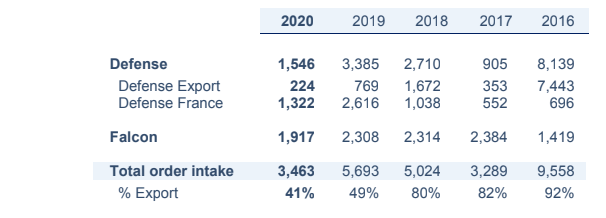
The order intake is composed entirely of firm orders.
Defense programs
In 2020, Defense order intake totaled EUR 1,546 million, compared with EUR 3,385 million in 2019.
The Defense Export share of the intake was EUR 224 million in 2020, compared with EUR 769 million in 2019, a year that saw significant military support.
The Defense France portion amounted to EUR 1,322 million in 2020, compared with EUR 2,616 million in 2019. Order intake includes the 10-year integrated support contract (excluding engines) for the ATL2 with the French Naval Air Force (“OCEAN”), the exercise of complementary options for the F4 standard, and the first study phases for the NGWS (“Next Generation Weapon System”). In 2019, it included the contractualization of the French 10-year integrated support contract for the Rafale (“RAVEL”).
Falcon programs
In 2020, 15 Falcon orders were recorded, compared with 40 in 2019. Order intake totaled EUR 1,917 million, versus EUR 2,308 million in 2019. This includes the “AVSIMAR” contract with France, for the development and acquisition of 7 Falcon 2000 LXS Albatros for maritime surveillance aircraft and associated support.
1.2 ADJUSTED NET SALES
Net sales for 2020 were EUR 5,489 million versus EUR 7,341 million in 2019. Export net sales represented 89%.
The change in net sales was as follows, in EUR million:
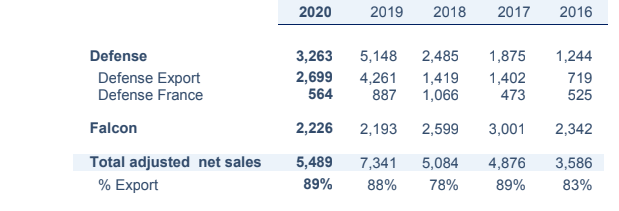
Defense programs
As forecast, 13 Rafale Export were delivered in 2020, versus 26 Rafale in 2019. For the record, on February 27, 2020, we published a guidance of 13 Rafale deliveries. After having suspended this guidance on April 1 due to the Covid-19 crisis, on July 23, 2020, we confirmed the guidance of 13 Rafale deliveries.
Defense net sales in 2020 were EUR 3,263 million versus EUR 5,148 million in 2019.
The Defense Export share was EUR 2,699 million versus EUR 4,261 million in 2019. This decrease was mainly due to a lower number of Rafale deliveries.
The Defense France share was EUR 564 million versus EUR 887 million in 2019. In accordance with the French Military Procurement Law, 2020 net sales for Defense France do not include any deliveries of the Rafale. However, they do include Rafale support services under the RAVEL contract. For the record, 2019 saw the delivery of developments for the upgrade of the ATL2 combat system and delivery of the first two upgraded aircraft to the French Navy.
Falcon programs
There were 34 Falcon delivered in 2020 (while 30 were guided), versus 40 in 2019. For the record, on February 27, 2020, we published a guidance of 40 Falcon deliveries. After having suspended this guidance on April 1 due to the Covid-19 crisis, on July 23, 2020, we published a new guidance of 30 Falcon deliveries.
Falcon net sales in 2020 totaled EUR 2,226 million, versus EUR 2,193 million in 2019. Net sales are stable, despite a lower number of deliveries of new aircraft, offset by an increase in the number of pre owned aircraft delivered.
1.3 BACKLOG
The consolidated order backlog as of December 31, 2020 was EUR 15,895 million versus EUR 17,798 million as of December 31, 2019. It consisted of:
∙ the Defense Export backlog, which was EUR 8,249 million versus EUR 10,725 million as of December 31, 2019. This consisted mainly of 34 Rafale, versus 47 Rafale as of December 31, 2019,
∙ the France Defense backlog, which was EUR 5,499 million, compared to EUR 4,740 million as of December 31, 2019. This included 28 Rafale (as of December 31, 2019), the RAVEL support contract for the Rafale, the OCEAN support contract for the ATL2, the Rafale F4 standard and the first study phases for the NGWS,
∙ the Falcon backlog (including the Albatros and Archange mission aircraft), which was EUR 2,147 million, compared with EUR 2,333 million as of December 31, 2019. It includes 34 Falcon, versus 53 as of December 31, 2019.
1.4 ADJUSTED RESULTS
Operating income
Adjusted operating income for 2020 was EUR 261 million, compared with EUR 765 million in 2019.
Operating margin was 4.8%, versus 10.4% in 2019. It is directly affected by:
∙ the financial impacts due to the health crisis (under-used capacity, cost of health measures, decline in activity at Falcon maintenance centers, etc.). The savings associated with the action plans implemented by the Group have cushioned these impacts,
∙ the significant level of self-financed R&D, representing 9.8% of net sales, compared with 7.2% in 2019. Despite the crisis, we aimed at keeping our current developments going, particularly the Falcon 6X and the future Falcon,
∙ less absorption of fixed costs due to the 25% drop in net sales.
The foreign exchange hedging rate was 1.18 $/€ in 2020, as in 2019.
Financial income
2020 adjusted financial income was EUR -34 million compared to EUR -52 million in 2019. In 2020, the impact associated with the financing component recorded under long-term military contracts was less significant due to deliveries of the Rafale Export. Financial income for 2020 was also positively impacted by the reduction in financial expenses following the repayment of borrowings in late 2019 and early 2020.
Net income
Adjusted net income for 2020 was down 51% at EUR 396 million, compared with EUR 814 million in 2019. Thales’ contribution to the Group’s net income was EUR 231 million, versus EUR 346 million in 2019.
As a result, adjusted net margin was 7.2% in 2020, as against 11.1% in 2019. This decrease is mainly due to the fall in operating income and the smaller contribution to net income from Thales (4.2% of net sales in 2020, versus 4.7% in 2019).
Net income per share for 2020 was EUR 47.6, compared with EUR 97.9 in 2019.
2. FINANCIAL STRUCTURE
2.1 AVAILABLE CASH
The Group uses a specific indicator called “Available cash”, which reflects the amount of total cash available to the Group, net of financial debts. It includes the following balance sheet items: cash and cash equivalents, current financial assets (at market value) and financial debt; it excludes lease liabilities recognized following the application of IFRS 16.
The Group’s available cash stands at EUR 3,441 million, EUR 1,144 million less than at December 31, 2019. The decrease is primarily due to the additional working capital requirement (resulting from the reduction in advances and progress payments received under export contracts following deliveries), and to the significant investments made during the period (including the purchase of land and buildings previously leased). These items are partially offset by operating cash flows generated during the year. In 2020, no dividends were paid to shareholders.
2.2 BALANCE SHEET (IFRS DATA)
Total equity stood at EUR 4,560 million as of December 31, 2020, versus EUR 4,446 million as of December 31, 2019.
Borrowings and financial debt totaled EUR 270 million as of December 31, 2020, against EUR 558 million as of December 31, 2019. EUR 250 million of bank borrowings were repaid in early 2020. Borrowings and financial debt mostly consist of locked-in employees’ profit-sharing funds, for EUR 123 million, and lease liabilities recognized following the implementation of IFRS 16, for EUR 147 million.
Inventories and work-in-progress rose slightly to EUR 3,382 million as of December 31, 2020, compared with EUR 3,368 million as of December 31, 2019. The increase in Defense France inventories and work in-progress was offset by the decrease in Defense Export inventories and work-in-progress, following the delivery of services under the Rafale Export contracts and the reduction in pre-owned Falcon inventory.
Advances and progress payments received on orders, net of advances and progress payments paid, fell by EUR 649 million as of December 31, 2020. This was mainly due to the reduction in progress payments following delivery of the Rafale Export during the period.
Derivative financial instruments had a market value of EUR 81 million as of December 31, 2020, compared with EUR -71 million as of December 31, 2019. This increase is essentially due to the change in the US dollar exchange rate between December 31, 2020 and December 31, 2019 (1.2271 $/€ versus 1.1234 $/€).
3. DIVIDENDS AND PROFIT-SHARING/INCENTIVES
The Board of Directors decided to propose to the Annual General Meeting a dividend distribution, in 2021, of EUR 12.3 per share, corresponding to a total of EUR 103 million, i.e., a payout of 26%.
For 2020, the Group will pay EUR 85 million in employee profit-sharing and incentives, including 20% correlated social tax, whereas the application of the legal formula would have resulted in a EUR 2 million payment.
4. SPLIT OF THE PAR VALUE OF THE SHARE
To align the share value with peers of the industry, to allow a better accessibility to individual investors, and to promote the liquidity of the stock, the Board of Directors decided to submit for the approval of the Annual General Meeting of May 11, 2021 a ten-for-one stock split, reducing the par value of Dassault Aviation shares from EUR 8 to EUR 0.80. This split would occur during the second half of 2021.
APPENDIX
DEFINITION OF ALTERNATIVE PERFORMANCE INDICATORS
To reflect the Group’s actual economic performance, and for monitoring and comparability reasons, the Group presents an adjusted income statement with the following elements:
∙ gains and losses resulting from the exercise of hedging instruments which do not qualify for hedge accounting under IFRS standards. This income, presented as financial income in the consolidated financial statements, is reclassified as net sales and thus as operating income in the adjusted income statement,
∙ the valuation of foreign exchange derivatives which do not qualify for hedge accounting, by neutralizing the change in fair value of these instruments (the Group considering that gains or losses on hedging should only impact income as commercial flows occur), with the exception of derivatives allocated to hedge balance-sheet positions whose change in fair value is presented as operating income,
∙ amortization of assets valued as part of the purchase price allocation (business combinations), known as “PPA”,
∙ adjustments made by Thales in its financial reporting.
The Group also presents the “available cash” indicator which reflects the amount of the Group’s total liquidities, net of financial debt. It covers the following balance sheet items:
∙ cash and cash equivalents,
∙ other current financial assets (essentially available-for-sale marketable securities at their market value),
∙ financial debt, except for lease liabilities recorded following the application of IFRS 16 “Leases”.
Only consolidated financial statements are audited by statutory auditors. Adjusted financial data are subject to the verification procedures applicable to all information provided in the annual report.
IMPACT OF AJUSTEMENTS
The impact in 2020 of adjustments to income statement aggregates is presented below:
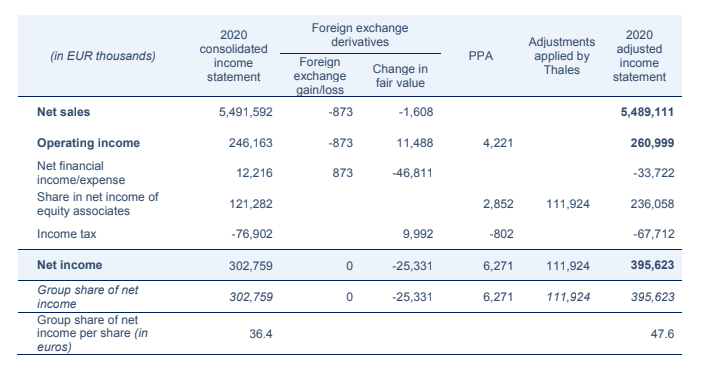
The impact in 2019 of adjustments to income statement aggregates is presented below:

Source: Dassault Aviation




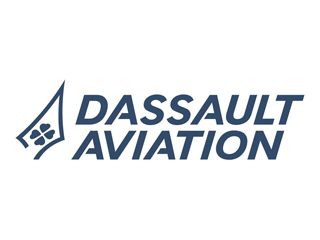
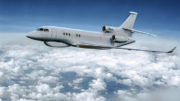

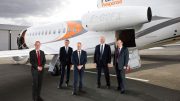

Be the first to comment on "KEY FIGURES OF DASSAULT AVIATION GROUP"